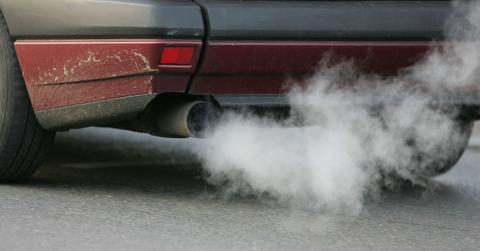COVID-19 Could Cause the Greatest Emissions Dive the World Has Seen Since World War II
Experts predict emission drops could reach World War II levels.
Updated Jan. 5 2021, 10:11 a.m. ET

The novel coronavirus pandemic draws several obvious parallels to World War II. Like the war, COVID-19 is taking lives, it’s devastating the economy, and major lifestyle changes are being required of people all over the world. One of the most interesting side effects of the coronavirus is the reduction in emissions in various areas on the planet — and according to new data, the coronavirus could actually cause the greatest emissions drop the world has seen since World War II.
The data and predictions come from Global Carbon Project, an organization that measures global greenhouse gas emissions and their causes. Rob Jackson, the organization’s chair and a professor at Stanford University, told Reuters that carbon output could fall by more than 5 percent year-on-year (a comparison of the time period of the coronavirus pandemic with the same dates the previous year). The last time we saw a dip almost as significant was in 2008 during the financial crisis, but that was only a 1.4 percent reduction year-on-year, according to Reuters. But the last time we saw an equally significant dip was back in the 1940s.
“I wouldn’t be shocked to see a 5 percent or more drop in carbon dioxide emissions this year, something not seen since the end of World War II,” Jackson told Reuters. “Neither the fall of the Soviet Union nor the various oil or savings and loan crises of the past 50 years are likely to have affected emissions the way this crisis is.”
However, accepting this forecast as “good news” is not so black and white — while the world is certainly in need of global greenhouse gas emissions to go down, these drops are only temporary. Once life starts to go “back to normal,” that normal will probably still be the one where humans are producing far more emissions than the planet can handle.
“This drop is not due to structural changes so as soon as confinement ends, I expect the emissions will go back close to where they were,” Corinne Le Quéré, a climate scientist at the University of East Anglia, told Reuters.
Other climate experts have echoed that sentiment over the past few weeks, in response to other reports on emissions and air pollution dropping during the pandemic. For example, Jill Baumgartner, an associate professor at McGill University, does not think emission drops related to the coronavirus crisis should be celebrated.
“This really shouldn’t be seen as a silver lining,” Baumgartner told The New York Times last month. “It’s not a sustainable way to reduce air pollution, and the long-term economic and well-being impacts of this crisis are going to be devastating for many people.”
How is the coronavirus causing carbon emissions to drop?
Emissions and air pollution are dropping most significantly in regions on lockdown due to high transmission rates of the virus. These areas have far less cars on the roads than usual, and various businesses and factories have suspended operations, meaning we're burning less fossil fuels and therefore emitting less greenhouse gases and air pollutants . Additionally, far less people are flying in airplanes due to the pandemic — it’s estimated that carbon emissions from air travel could drop by more than 33 percent by the end of the year.
Where are emissions down due to the coronavirus?
Both northern Italy and China have generated reduced nitrogen dioxide (NO2) emissions over the past few months. Major U.S. cities including New York City, Los Angeles, Chicago, Seattle, and Atlanta have all experienced reductions in NO2 and carbon monoxide. And across India, levels of the dangerous air pollutant PM 2.5 as well as NO2 have dropped significantly as well, noticeably improving air quality in the country.
The best way to prevent contracting or spreading coronavirus is with thorough hand washing and social distancing. If you feel you may be experiencing symptoms of coronavirus, which include persistent cough (usually dry), fever, shortness of breath, and fatigue, please call your doctor before going to get tested. For comprehensive resources and updates, visit the CDC website. If you are experiencing anxiety about the virus, seek out mental health support from your provider or visit NAMI.org.